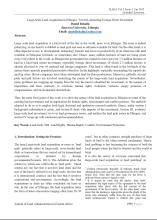Land Library Search
Through our robust search engine, you can search for any item of the over 73,000 highly curated resources in the Land Library.
If you would like to find an overview of what is possible, feel free to peruse the Search Guide.
/ library resources
Showing items 1 through 9 of 56.The recent phenomenon of large-scale acquisition of land for a variety of investment purposes has raised deep concerns over the food security, livelihood and socio-economic development of communities in many regions of the developing world.
This publication provides an overview of the findings of a review of land tenure security in Asia and the Pacific region in collaboration with key partners.
This paper examines regulatory approaches for informal livelihood activities within cities. Informality is generally conceptualised in terms of activities, workers and governance. Scholars have concentrated much advocating development of micro enterprise and improvement of capital goods.
Large scale land acquisition is a buzzword of the day in the world, more so in Ethiopia. The issue is indeed polarizing, in one hand it is dubbed as land grab and seen as ultimate scramble for land.
FIRST PARAGRAPH: The historical weight of the political culture of development in Burma – now more commonly referred to as Myanmar – must not be discounted during the democracy-neoliberal reform era.
Successful development experiences have demonstrated the greater efficiency achieved with a growth strategy based on small and medium-scale farmers (SMFs).
The type of agrarian structure employed to produce tropical commodities affects many dimensions of land use, such as ownership inequality, overlapping land rights and conflicts, and land use changes.
ABSTRACTED FROM OPENING PARAGRAPHS: Land confiscation is one of the leading causes of protest and unrest in Burma, having led to the forced displacement of hundreds of thousands of people in recent years. It also undermines Burma’s fragile peace processes.
Rural change in Cambodia manifests itself in rapidly declining land availability for the smallholder sector, posing the question of how farmers may be able to deal with limited access to land.





